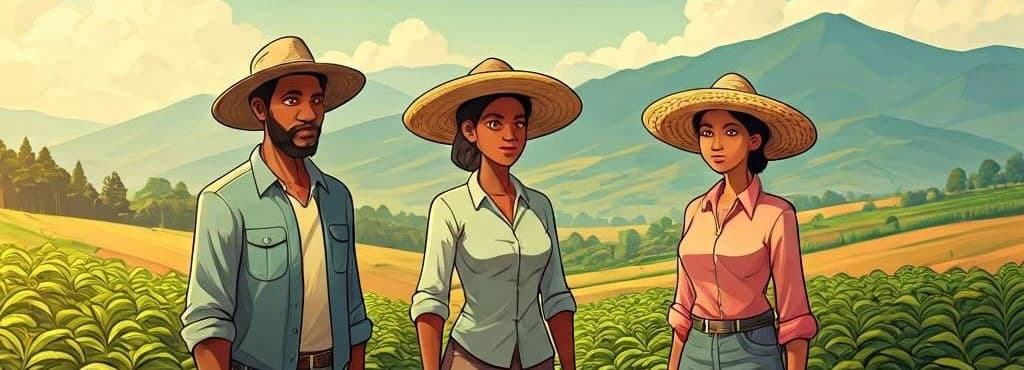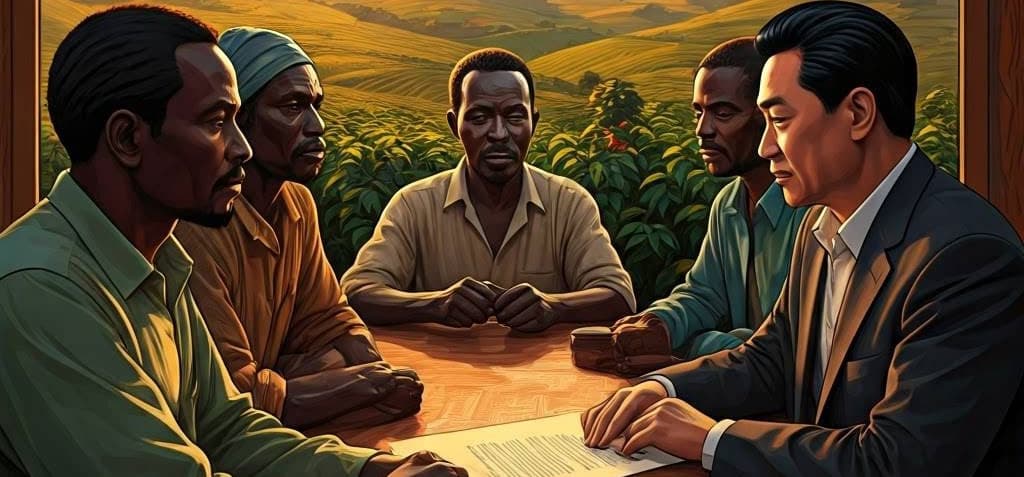Estimated Reading Time: Approximately 10-12 minutes for an average reader.
Introduction
In this update, we discuss the factors driving up coffee prices. If you are not interested in the specifics and just want to know how this affects our prices by the end of February, scroll to the section titled “How It Affects You.”
Coffee Prices Are Being Driven Up
Coffee prices have been steadily increasing over the last 18 months, with significant and dramatic rises occurring in the past 8 months, with further increases highly probably. A combination of factors has contributed to this surge, driving coffee prices to all-time highs. Here are some key reasons we believe this has happened:
- Coffee producers facing production shortages.
- Rising production costs.
- Supply chain disruptions.
- Strong global demand.
- China’s growing buying power.
- Speculation.
- Geopolitical factors.
- Long-term structural issues.
- Rising prices of Robusta coffee.

Coffee Production Shortages
- Brazil’s Frosts and Droughts: Brazil, the world’s largest coffee producer, experienced severe frosts in mid-2021 and prolonged droughts in 2022. These events damaged Arabica coffee crops, which take years to recover, leading to a significant reduction in supply.
- Vietnam’s Reduced Coffee Production Area: Vietnam, the world’s largest producer of Robusta and the second-largest coffee producer overall, has seen a decline in coffee production due to a reduction in cultivation area and lower yields. More profitable crops have replaced coffee, further straining the global supply.
- Hurricanes and Heavy Rains in Central America: Countries like Honduras, Guatemala, and Nicaragua, major producers of Arabica beans, faced hurricanes and excessive rainfall in 2022. These conditions disrupted harvests, reduced yields, and forced many farmers to abandon their farms and move to urban areas. Recovery will take years.
- El Niño Concerns: The potential onset of El Niño in 2023 has raised fears of further weather disruptions, including droughts in Southeast Asia (affecting Robusta production) and excessive rains in South America.

Rising Production Costs
- Fertilizer Prices: The Russia-Ukraine war disrupted global fertilizer supplies, as Russia and Belarus are major exporters of potash and other fertilizers. This led to a sharp increase in fertilizer costs, making coffee farming more expensive.
- Energy Prices: Higher fuel and energy prices, exacerbated by the Russia-Ukraine conflict, increased the cost of irrigation, transportation, and processing.
- Labour Costs and Shortages: Many coffee-producing countries faced labour shortages due to migration and the lingering effects of the COVID-19 pandemic, driving up wages for farmworkers. Border closures have also limited access to migrant labour, which is critical for coffee farms.
- Rise in Certification Costs: For growers seeking certifications like USDA, IFOAM, and Fairtrade, certification costs have increased by 10-20%.

Supply Chain Disruption
- Shipping Delays and Costs: Global shipping costs remain high due to port congestion, container shortages, and higher fuel prices, making it more expensive to transport coffee from producing to consuming countries.
- Export Restrictions: Some producing countries, such as Vietnam, have faced logistical challenges and occasional export restrictions, further tightening global supply.
- Pressure on Critical Sea Routes: Conflicts and attacks in regions like the Red Sea have severely impacted shipping through the Suez Canal. This has led to a significant decrease in trade volume, forcing ships to reroute around the Cape of Good Hope, adding time and costs. Additionally, the Panama Canal is facing challenges due to severe drought, which has reduced water levels and limited the number of ships that can pass through. These issues have raised concerns about the long-term resilience of global supply chains.

Strong Global Demand
- Post-Pandemic Recovery: As economies reopened after the COVID-19 pandemic, demand for coffee rebounded sharply, particularly in cafes and restaurants. This surge in demand coincided with constrained supply, pushing prices higher.
- Growth in Emerging Markets: Countries like China and India have seen rapid growth in coffee consumption, driven by urbanization, a growing middle class, and the popularity of coffee culture. The growth in these markets alone exceeds the total demand in South Africa.
- Growth at Origin: Many coffee-producing countries have also seen a dramatic increase in local demand. A surge in roasters and cafes in these regions has reduced the amount of coffee available for export.
- Specialty Coffee Boom: The rise of specialty coffee and premium coffee products has increased demand for high-quality Arabica beans, which are already in short supply.

The Chinese Effect
China’s growing influence on coffee prices is significant. Key points include:
- China’s Growing Coffee Market: China’s coffee consumption has risen rapidly, driven by urbanization, a growing middle class, and the popularity of coffee chains like Luckin Coffee and Starbucks. To meet this demand, China has been sourcing coffee beans from major producers like Brazil, Vietnam, Colombia, and Ethiopia. Their annual growth in demand exceeds South Africa’s total coffee consumption.
- Long-Term Contracts and Higher Prices: China has secured long-term supply contracts for agricultural commodities, including coffee, to ensure stable supplies and hedge against price volatility. Paying higher prices for long-term contracts helps China build strong relationships with producers and secure preferential access to high-quality beans.
- Global Coffee Trade Dynamics: China’s strategy aligns with its broader approach to securing food and agricultural resources globally, often through investments, partnerships, and trade agreements. This trend is part of China’s Belt and Road Initiative (BRI), which includes agricultural cooperation with participating countries.

Speculation and Market Dynamics
- Futures Market Activity: Speculative trading in coffee futures on commodity exchanges like the Intercontinental Exchange (ICE) has amplified price movements. Traders have reacted to supply concerns by driving prices higher.
- Currency Fluctuations: Coffee is traded in U.S. dollars, and the strength of the dollar relative to currencies in producing countries (e.g., the Brazilian real or Colombian peso) has impacted prices. A stronger dollar makes coffee more expensive for buyers using other currencies.

Geopolitical and Economic Factors
- Russia-Ukraine War: The conflict disrupted global trade, increased energy prices, and contributed to inflation, all of which indirectly impacted coffee prices.
- Other Conflicts: Conflicts in other regions, as well as civil wars and skirmishes in producing countries, have further strained supply chains.
- Reduce access to markets: With cooperative trade agreements and open boarder policies being shut down, trade costs have increased. Driving up warehousing costs and additional levies being placed on trading countries.
- Inflation and Economic Uncertainty: Global inflation and economic uncertainty have increased the cost of inputs like labour, packaging, and transportation.
- Threat of Sanctions and Tariffs: International threats of sanctions and tariffs on producing countries have also driven price increases, particularly in speculative markets.
- Withdrawal of aid: While the long-term effect of the withdraw of US Aid is starting to motivate the speculators, many producing countries are dependent on AID centres that have been setup to improve production and quality. The short-term effects have been felt, but the long-term effects are expected to also drive the coffee price up and probably affect production.

Long-Term Structural Issues
- Aging Coffee Trees: An increasing number of coffee farms have aging trees that are less productive. Replanting requires significant investment and time, constraining supply growth.
- Aging Producers: The aging population of coffee producers, coupled with a lack of interest from the next generation in taking over family farms, has resulted in reduced productivity and, in some cases, farm abandonment. While not a new problem, it has started adding pressure to coffee production.
- Climate Change: Long-term climate shifts are making coffee cultivation more challenging, as coffee plants are sensitive to temperature and rainfall changes. This has reduced productivity in traditional growing regions.
Rising Price of Robusta
Robusta (Coffea canephora) is the second most consumed coffee species. Vietnam and Brazil together produce over 60% of the world’s Robusta. With the pressures on these producing countries, Robusta prices have increased, driving up the price of Arabica as well. While Robusta is considered as an alternative to Arabica (this may anger some stalwarts of Italian espresso blends), its price increases’ directly result in the Arabica prices increasing.
Is there good news?
While the above seems to be doom and gloom there are a few positive stories too.
- Consolidation: Driven by a need to be profitable several small co-operatives and farms have started consolidating. Farms from deceased estates that were too small, and families have not been interested in farming, have sold to neighbours and this will help with production. Several smaller co-operatives have found it hard to survive and have consolidated with other local co-operatives. While this has caused job loses, in the long run the larger co-operatives are expected to produce more efficiently.
- New production areas and young farmers: As the prices have gone up, a new crop (pun intended) of younger farmers have entered the coffee production, normally diversifying crops, using more modern methods, and even introducing more environmentally sustained practices. Some of these newer entries have used land that was not typically associated to coffee production, were abandoned or were mostly mono crop farms. These farms are young, and at the moment producing a small amount, but there is a positive outlook. This may have ripple effects in the current producing areas, bringing a younger generation back into land families were using less effectively.
- Closer to living wage for more farmers: The coffee industry has known for years that coffee at below $2 a pound was not sustainable. As the price hovers around $4 this means that more farmers, especially small-scale farmers are close to securing a living wage, especially if the prices remain about $3 a pound. A direct result will be that producers that had abandoned their farms may return and attract future generations into coffee production.

How This Affects You, the Coffee Drinker
Whenever the cost of raw materials increases, the price of the final product must also rise. For us, the final product is coffee beans. At Quaffee, we have endured significant price increases over the past 8 months, and we’ve reached a tipping point. While we love sharing our coffees, we must remain financially (and environmentally) sustainable. The prices we pay for raw coffee and consumables have increased by 40-70%.
We have done everything we can to limit the impact of these increases on our customers, whom we deeply appreciate. We understand that many of you are passionate not only about coffee but also about how it reaches you. While we’ve explored using lower-quality coffee in blends, there’s a limit to how far we’ll go. We must ensure that producers are fairly rewarded for their efforts.
So, what can you expect? We will be increasing our coffee prices by 20-30% at the end of February 2025. This increase is directly linked to the rising costs of the coffees we offer. Will this be enough? We are not sure. If coffee prices continue to rise and fail to stabilise (as has happened in the past), we may need to review our pricing again.
We thank you for your support and understanding. We look forward to continuing to offer you delicious coffee with a commitment to sustainability.



